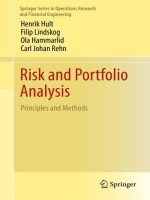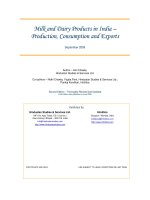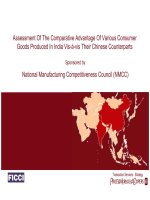Equity markets in india returns, risk and price multiples
Bạn đang xem bản rút gọn của tài liệu. Xem và tải ngay bản đầy đủ của tài liệu tại đây (2.02 MB, 201 trang )
India Studies in Business and Economics
The Indian economy is considered to be one of the fastest growing economies of the world with India
amongst the most important G-20 economies. Ever since the Indian economy made its presence felt on
the global platform, the research community is now even more interested in studying and analyzing
what India has to offer. This series aims to bring forth the latest studies and research about India from
the areas of economics, business, and management science. The titles featured in this series will
present rigorous empirical research, often accompanied by policy recommendations, evoke and
evaluate various aspects of the economy and the business and management landscape in India, with a
special focus on India’s relationship with the world in terms of business and trade.
More information about this series at http://www.springer.com/series/11234
Shveta Singh, P. K. Jain and Surendra Singh Yadav
Equity Markets in India
Returns, Risk and Price Multiples
1st ed. 2016
Shveta Singh
Department of Management Studies, Indian Institute of Technology Delhi, New Delhi, India
P. K. Jain
Department of Management Studies, Indian Institute of Technology Delhi, New Delhi, India
Surendra Singh Yadav
Department of Management Studies, Indian Institute of Technology Delhi, New Delhi, India
ISSN 2198-0012
e-ISSN 2198-0020
ISBN 978-981-10-0867-2 e-ISBN 978-981-10-0868-9
DOI 10.1007/978-981-10-0868-9
Library of Congress Control Number: 2016935967
© Springer Science+Business Media Singapore 2016
This work is subject to copyright. All rights are reserved by the Publisher, whether the whole or part
of the material is concerned, specifically the rights of translation, reprinting, reuse of illustrations,
recitation, broadcasting, reproduction on microfilms or in any other physical way, and transmission
or information storage and retrieval, electronic adaptation, computer software, or by similar or
dissimilar methodology now known or hereafter developed.
The use of general descriptive names, registered names, trademarks, service marks, etc. in this
publication does not imply, even in the absence of a specific statement, that such names are exempt
from the relevant protective laws and regulations and therefore free for general use.
The publisher, the authors and the editors are safe to assume that the advice and information in this
book are believed to be true and accurate at the date of publication. Neither the publisher nor the
authors or the editors give a warranty, express or implied, with respect to the material contained
herein or for any errors or omissions that may have been made.
Printed on acid-free paper
This Springer imprint is published by Springer Nature The registered company is Springer
Science+Business Media Singapore Pte Ltd.
To
the Almighty
and
our family members
Preface
Great deeds are usually wrought at great risk
—Herodotus
Equity markets constitute the most important segment of stock exchanges. In fact, status of equity
returns is, by and large, reckoned as a barometer of the state of the economy of a country. Returns
earned by equity investors on their funds invested in equity markets would be a decisive factor in the
growth of such markets. What has been the experience of Indian equity markets constitutes the subject
matter of this book.
It would be useful for equity investors to know the expected returns (on a rational basis) and
actual returns earned on their investments; equally important for them would be to have an insight into
the risk-return trade-off involved in equity investment and the factors that affect the same.
A study comprising, possibly, the largest sample of the National Stock Exchange’s (NSE) 500
index companies (representing almost 97 % of the market capitalisation) has not been undertaken so
far, in India. The period of the study is spread over two decades (1994–2014) tracking returns right
from the inception of the index till the present. This book would, provide a comprehensive view of
equity returns in India.
This book would deepen the investor’s understanding of equity investment and, thus, help him
become a more informed investor. Apart from this, this study would contribute significantly to the
existing body of literature on market returns and prove to be of some value to academic researchers
and market participants (financial institutions and other intermediaries), regulators and policy makers.
Acknowledgements
At the outset, we would like to thank the Almighty for His blessings to inspire us to accomplish this
academic endeavour. This work has been possible because of the help, encouragement, cooperation
and guidance of many people and we convey our heartfelt thanks to all of them. Special thanks to the
Modi Chair Foundation for funding the research effort. We are grateful to Prof. Kshitij Gupta,
Director, IIT Delhi and Prof. R.K. Shevgaonkar, ex-Director, IIT Delhi, for their encouragement and
support. We express our gratitude towards Prof. M. Balakrishnan (ex-DDF) and Prof. Sushil, exDean (Faculty), for their unstinting support. Our thanks are also due to Prof. S.N. Singh (ex-Dean,
IRD), Prof. Sunil Tuli, Dean (IRD), Mr. V.K. Vashistha, AR (IRD), Mr. R.K. Gupta (ex-AR, IRD
Accounts), Mr. Anup Kuksal, AR (IRD Accounts) and IRD staff for their support for our academic
endeavour.
To thank the Head of the Department may seem to be a ritual. But it is not so in the case of Prof.
Kanika T. Bhal, Head, Department of Management Studies (DMS). She has been supportive
throughout. We thank Prof. Ravi Shankar for engaging in discussions from time to time and all our
colleagues in the Department for their good wishes for this endeavour.
We are grateful to our students, Apurv Manvar, and our research scholars, Monika Singla,
Vandana Bhama and Sadaf Anwar, for their help with the data collection. We thank our student
Nishant Vats for his help with data collation and processing and our research scholar Harshita for
preparing the table of contents and lists of figures, etc.
Dr. Shveta Singh takes this opportunity to express her deepest gratitude to her gurus and coauthors, Prof. P.K. Jain and Prof. Surendra Singh Yadav, for their valuable guidance, inspiration,
motivation and untiring efforts in completion of this project. She also thanks Anil, her husband, for his
unwavering support and encouragement. Professor P.K. Jain acknowledges the patience,
understanding, cooperation and encouragement of his wife, Uma.
Last but not least, we are thankful to all those, not mentioned above, who have helped in carrying
out the study, our family members and loved ones for their continuous encouragement and support.
Shveta Singh
P. K. Jain
Surendra Singh Yadav
Abbreviations
ADF Augmented Dickey–Fuller test
ADR American Depository Receipts
AE Abnormal Earnings
AIC Akaike Information Criteria
ANFN Adaptive Neural-Fuzzy Networks
ANOVA Analysis of Variance
APARCH Asymmetric Power Autoregressive Conditional Heteroskedasticity
ARCH Autoregressive Conditional Heteroskedasticity
ARDL Autoregressive Distributed Lag test
ARIMA Autoregressive Integrated Moving Average
β
Beta
BE Brand Equity
BEML Bharat Earth Movers Limited
BRIC Brazil, Russia, India and China
BRICA Brazil, Russia, India, China and Argentina
BSE Bombay Stock Exchange
BV/MV Book Value to Market Value
CAPM Capital Asset Pricing Model
CART Classification and Regression Tree
CEO Chief Executive Officer
CFO Chief Financial Officer
CRISIL Credit Rating Information Services of India Limited
CRSP Centre for Research in Security Prices
CS Customer Satisfaction
DCL Degree of Combined Leverage
DF Dickey Fuller test
DFL Degree of Financial Leverage
DOL Degree of Operating Leverage
D p Preference Dividend
D/P Dividend Pay-out ratio
DPS Dividend per Share
DSE Dhaka Stock Exchange
EAT Earnings after Taxes
EBIT Earnings before Interest and Taxes
ECM Error-Correction Model
EGARCH Exponential General Autoregressive Conditional Heteroskedasticity
E/P Earnings-to-Price ratio
EPS Earnings per Share
EW Equal Weighted
E&Y Ernst and Young
FD Fixed Deposit
FDI Foreign Direct Investment
GAAP Generally Accepted Accounting Principles
GARCH General Autoregressive Conditional Heteroskedasticity
GARCH-M General Autoregressive Conditional Heteroscedasticity-Mean
GCC Gulf Cooperation Council
GDP Gross Domestic Product
GSADF Generalized Supremum Augmented Dickey–Fuller test
ICT Internet, Communications Technology
IGARCH Integrated Generalized Autoregressive Conditional Heteroscedasticity
IISL India Index Services and Products Limited
IMF-FSF International Monetary Fund-Financial Stability Forum
INR Indian Rupee
IPO Initial Public Offering
IRR Internal Rate of Return
IVP Indira Vikas Patra
J–J Johansen–Juselius test
Ke Cost of Equity
KPSS Kwiatkowski–Phillips–Schmidt–Shin statistics
KSE Karachi Stock Exchange
KVP Kisan Vikas Patra
LDA Linear Discriminant Analysis
MPS Market Price per Share
M-TAR Momentum-Threshold Autoregression test
NASDAQ National Association of Securities Dealers Automated Quotations
NSC National Savings Certificates
NSE National Stock Exchange
NYSE New York Stock Exchange
OECD Organization for Economic Cooperation and Development
OLS Ordinary Least Squares
P/B Price-to-Book-Value ratio
P/E Price-to-Earnings ratio
P–P Philips–Perron statistics
PPF Public Provident Fund
PSU Public Sector Undertaking
PwC PricewaterhouseCoopers
QDA Quadratic Discriminant Analysis
QMLI Quasi-Maximum Likelihood Estimation
Q–Q Quantile–Quantile
RBI Reserve Bank of India
R f Risk-Free Return
R m Market Return
ROE Return on Equity
ROEF Return on Equity Funds
ROR Rate of Return
S&P Standard & Poor’s
SADF Supremum Augmented Dickey–Fuller test
SEBI Securities and Exchange Board of India
SEC Securities and Exchange Commission
SENSEX Sensitive Index
SG Sales Growth
SIC Schwarz–Bayesian Information Criteria
SPSS Statistical Package for Social Sciences
SV Shareholder Value
TAR Threshold Autoregressive test
TARCH Threshold Autoregressive Conditional Heteroskedasticity
TASE Tel Aviv Stock Exchange
TDS Thomson Datastream
UK United Kingdom
ULIPs Unit Linked Insurance Plans
UNCTAD United Nations Council for Trade and Development
USA United States of America
VaR Value at Risk
V/P Value-to-Price ratio
WTO World Trade Organization
Contents
1 Introduction
Section I: Literature Review
Equity Market Studies
Factors Affecting Returns
Section II: Objectives
Section III: Research Methodology
Scope
NSE 500 Index Background
Secondary Data and Analysis
Data Analysis
Section IV: Layout of the Study
Section V: Summary
Annexure 1.1: Constituent Companies and Sectors of NSE 500 (as on 11 March 2013)
References
2 Rates of Return on Equity Funds (ROEF)—Corporates’ Perspective
Introduction
Section I: Literature Review
Risk Factors/Determinants Affecting ROE
Impact of Recent Financial Crisis on India
Section II: Scope, Data and Methodology
Scope
NSE 500 Index Background
Secondary Data and Analysis
Data Sources and Analysis
Section III: Rates of Return from the Company’s Perspective—ROEF
Section IV: Summary
References
3 Expected Rates of Return
Introduction
Section I: Literature Review
Section II: Scope, Data and Methodology
Scope
NSE 500 Index Background
Secondary Data and Analysis
Section III: Expected Rates of Return Based on Capm
Section IV: Expected Rates of Return—Cost of Equity
Section V: Summary
References
4 Rates of Return—Investors’ Perspective
Introduction
Section I: Literature Review
Factors Affecting Returns
Behaviour of Share Prices
Section II: Scope, Data and Methodology
Scope
NSE 500 Index Background
Secondary Data and Analysis
Section III: Portfolio Returns for Varied Holding Periods
Section IV: Overall Characteristics of Returns
Periods of High Returns
Periods of Low Returns and Losses
Magnitude of Variations
Three Phases
Two Components of Total Return
Declining Importance of Dividend
Comparison with Debt Instruments
Section V: Concluding Observations
Annexure 4.1
Example of Bonus Share Adjustment
Example for Rights Issue Adjustment
References
5 Rates of Return—Disaggregative Analysis
Section I: Introduction
Age
Size
Ownership Structure
Underlying Sector/Industry Affiliation
Section II: Literature Review
Section III: Methodology
Scope
NSE 500 Index Background
Secondary Data and Analysis
Section IV: Returns Based on the Age, Size, Ownership Structure and Underlying Sector/
Industry Affiliation of Sample Companies
Age
Size
Ownership Structure
Underlying Sector/Industry Affiliation
Section V: Summary
References
6 Analysis of Price Multiples
Introduction
Section I: Literature Review
Section II: P / E Ratios in India
Interpreting the P / E Ratio: A Word of Caution
Earnings Per Share (EPS)
Relationship Between EPS and Prices
P / B Ratio
Section III: Scope, Data and Methodology
Scope
NSE 500 Index Background
Secondary Data and Analysis
Section IV: Price Multiples
Section V: Summary
References
7 Volatility in Stock Returns
Introduction
Section I: Literature Review
International Studies on Behaviour of Returns
Indian Studies on Behaviour of Returns
Section II: Scope, Data and Methodology
Scope
NSE 500 Index Background
Secondary Data and Analysis
Methodology
Formulation of Hypotheses
Section III: Index Returns and Their Statistical Treatment
Section IV: Summary
Annexure 7.1: Glossary of Terms
Annexure 7.2: Ljung-Box Q 2 Statistics
Annexure 7.3: Lagrange Multiplier Test
Annexure 7.4: Stationarity Test Statistics
References
8 Level of Market Efficiency Using ‘Rational Bubbles’ Approach
Section I: Introduction
Section II: Literature Review
Rational Bubbles
Share Price Changes
Section III: Methodology
Scope
NSE 500 Index Background
Secondary Data and Analysis
Section IV: Statistical Models Used to Test the Presence of ‘Rational Bubbles’
Unit Root Test
Tests for Cointegration
Section V: Results and Discussion
Unit Root Test
Threshold Autoregressive (TAR) Test
Momentum-Threshold Autoregressive (M-TAR) Test
M-TAR Error Correction Model
Section VI: Summary
Annexure 8.1: Brief Definition of Theories and Terms
Annexure 8.2: Augmented Dickey–Fuller (ADF) Test Results
Annexure 8.3: Results of TAR Cointegration Test
Annexure 8.4: Estimation Results of M-TAR Error Correction Model (ECM)
Annexure 8.5: Summary and Diagnostic Checking for M-TAR Models (1 and 2)
Annexure 8.6: Granger Causality and Path Asymmetry Test
Annexure 8.7: Engle–Granger Test Results
Annexure 8.8: ARDL Bound Test Results
Annexure 8.9: Johansen–Juselius Test Results
References
9 Concluding Observations
Section I: Returns on Equity
Section II: Analysis of Price Multiples
Section III: Risk/Volatility in Returns
Section IV: Level of Market Efficiency
Section V: Summary
References
List of Figures
Figure 2.1 Mean values of ROEF for sample companies, 2004–2014
Figure 3.1 Mean values of operating leverage of the sample companies, 2001–2014
Figure 3.2 Mean values of financial leverage of the sample companies, 2001–2014
Figure 4.1 Rates of return for the fifteen-year holding period
Figure 4.2 Rates of return for the ten-year holding period
Figure 4.3 Rates of return for the five-year holding period
Figure 4.4 Rates of return for the one-year holding period
Figure 4.5 Twenty-five years of bank interest rates in India ( source Capitalmind website 2014)
Figure 5.1 Segregation of the sample companies on the basis of age
Figure 5.2 Segregation on the basis of ownership structure of sample companies
Figure 6.1 Mean values of P / E ratio for sample companies, 2001–2014
Figure 6.2 Mean values of P / B ratio for sample companies, 2001–2014
Figure 7.1 Histogram of the NSE 500 daily returns, 1999–2014
Figure 7.2 Time Path of the NSE 500 daily closing prices, 1999–2014
Figure 7.3 Volatility patterns (deviations) of the NSE 500 index based on daily closing prices, 1999–
2014
Figure 7.4 Q–Q plot of daily closing prices of the NSE 500 index, 1999–2014
List of Tables
Table 1.1 Sector-wise classification of NSE 500 companies
Table 1.2 Sector-wise reclassification of sample companies
Table 2.1 Mean, standard deviation, coefficient of variation, skewness, kurtosis, median and quartile
values related to return on equity funds (ROEF) of sample companies, 2004–2014
Table 2.2 Frequency distribution related to ROEF of sample companies, 2004–2014
Table 3.1 Expected returns for the sample companies and their comparison with market index returns
for the period, 2001–2014 (figures are in percentage)
Table 3.2 Mean, standard deviation, variance, coefficient of variation, minimum, maximum,
skewness, kurtosis and quartile values of expected and market index returns, 2001–2014
Table 3.3 Mean, standard deviation, coefficient of variation, skewness, kurtosis, median and quartile
values of degree of operating leverage (DOL) and degree of financial leverage (DFL) of sample
companies, 2001–2014
Table 3.4 Frequency distribution pertaining to the degree of operating leverage (DOL) and degree of
financial leverage (DFL) of sample companies, 2001–2014 (figures are in percentages)
Table 3.5 Assignment of risk premium rate for DOL and DFL
Table 3.6 Cost of equity based on the risk premium approach
Table 4.1 Rates of return for the fifteen-year holding period (when equities were purchased at the
year’s average price and then sold 15 years later, at the terminal year’s average price)
Table 4.2 Rates of return for the ten-year holding period (when equities were purchased at the year’s
average price and then sold 10 years later, at the terminal year’s average price)
Table 4.3 Rates of return for the five-year holding period (when equities were purchased at the year’s
average price and then sold 5 years later, at the terminal year’s average price)
Table 4.4 Rates of return for the one-year holding period
Table 4.5 Comparison of different investment avenues—2015
Table 5.1 Mean, minimum, maximum, standard deviation, coefficient of variation, skewness, kurtosis,
median and quartile values related to the age of sample companies
Table 5.2 Mean, minimum, maximum, standard deviation, coefficient of variation, skewness, kurtosis,
median and quartile values related to the size of sample companies
Table 5.3 Sector-wise reclassification of sample companies
Table 5.4 Weighted annual average returns and statistics of mean, standard deviation, variation,
coefficient of variation, skewness, kurtosis and quartile values of returns on the basis of age of
sample companies, 2001–2014
Table 5.5 Weighted annual average returns and statistics of mean, standard deviation, variation,
coefficient of variation, skewness, kurtosis and quartile values of returns on the basis of size of
sample companies, 2001−2014
Table 5.6 Weighted annual average returns and statistics of mean, standard deviation, variation,
coefficient of variation, skewness, kurtosis and quartile values of returns on the basis of ownership
structure of sample companies, 2001−2014
Table 5.7 Weighted annual average returns and statistics of mean, standard deviation, variation,
coefficient of variation, skewness, kurtosis and quartile values of returns on the basis of underlying
sector of sample companies, 2001−2014
Table 6.1 Interpretation of P / E ratios
Table 6.2 Frequency distribution related to P / E ratio of sample companies, 2001–2014
Table 6.3 Mean, standard deviation, coefficient of variation, skewness, kurtosis, median and quartile
values related to P / E ratio of sample companies 2001–2014
Table 6.4 Growth in EPS vis-à-vis P / E multiples for sample companies, 2001–2014
Table 6.5 Frequency distribution related to P / B ratio of sample companies, 2001–2014
Table 6.6 Mean, standard deviation, coefficient of variation, skewness, kurtosis, median and quartile
values related to P / B ratio of sample companies 2001–2014
Table 7.1 Mean, standard deviation, variance, kurtosis, skewness and range in daily returns of the
NSE 500, 1999–2014
Table 8.1 Descriptive statistics of log (price) and log (dividends)
Table 8.2 Results of M-TAR cointegration test
List of Annexures
Annexure 1.1 Constituent Companies and Sectors of NSE 500 (as on 11 March 2013)
Annexure 4.1 Example of Bonus Share Adjustment
Example for Rights Issue Adjustment
Annexure 7.1 Glossary of Terms
Annexure 7.2 Ljung-Box Q 2 Statistics
Annexure 7.3 Lagrange Multiplier Test
Annexure 7.4 Stationarity Test Statistics
Annexure 8.1 Brief Definition of Theories and Terms
Annexure 8.2 Augmented Dickey–Fuller (ADF) Test Results
Annexure 8.3 Results of TAR Cointegration Test
Annexure 8.4 Estimation Results of M-TAR Error Correction Model (ECM)
Annexure 8.5 Summary and Diagnostic Checking for M-TAR Models (1 and 2)
Annexure 8.6 Granger Causality and Path Asymmetry Test
Annexure 8.7 Engle–Granger Test Results
Annexure 8.8 ARDL Bound Test Results
Annexure 8.9 Johansen–Juselius Test Results
About the Authors
Shveta Singh
is an Associate Professor of Finance at the Department of Management Studies, Indian Institute of
Technology (IIT Delhi), India. She teaches courses on managerial accounting and financial
management, indian financial system and security analysis and portfolio management. Recently, she
has developed a course on corporate governance and has also received training by the International
Finance Corporation (IFC) in collaboration with the Indian Institute of Corporate Affairs (IICA), for
the same. She has contributed to various consulting assignments for organizations like the Directorate
General of Supplies & Disposals (DGS&D) and the National Buildings Construction Corporation
(NBCC).
Overall, she has more than a decade of professional experience, having spent 3 years in the
corporate sector prior to joining academics. She has published research papers in journals of national
and international repute. She has been honoured with the “Leadership” award which she accepted on
behalf of IIT Delhi from the Institute of Business and Finance Research at the Global Conference on
Business and Finance in USA. She also won the “Best in Session” award at the same conference. She
was also honoured with the “Literati” award for outstanding research by Emerald Publishing Inc. She
also received a mention for the “Most Downloaded Paper” by the Journal of Advances in
Management Research, UK.
P. K. Jain
is a Professor of Finance at the Department of Management Studies, IIT, Delhi. He has earlier served
as the Co-ordinator of the Dalmia Research Programme on Management in Asia and also as the Modi
Foundation Chair Professor.
He has a teaching experience of more than 40 years in subjects related to management accounting,
financial management, financial analysis, cost analysis and cost control. His research is primarily
focused in the area of corporate finance. He has authored/co-authored more than 11 textbooks and 14
research books/monographs. An empiricist, he investigates applied problems using real-business data
to have the managerial implications of various financial aspects. He has published more than 160
research papers in the journals of national and international reputation. Recently, his paper “Capital
Budgeting Decisions: Evidence from India” has been adjudged with the “Literati Award” by Emerald
for Outstanding Excellence in Research. He is on the board of academic institutions and reviewer of
journals like Vision, Abhigyan, Vikalp, Finance India, Management and Change.
Surendra Singh Yadav
is currently a Professor at the Department of Management Studies, IIT, Delhi. He teaches corporate
finance, international finance, international business, and security analysis & portfolio management.
He has been a visiting professor at University of Paris, Paris School of Management and INSEEC









